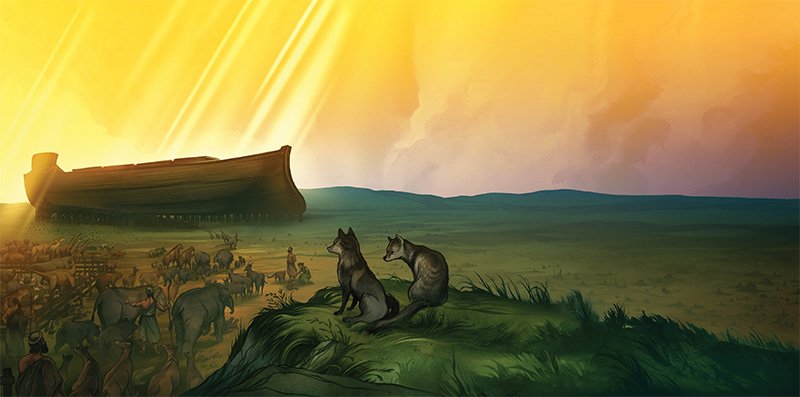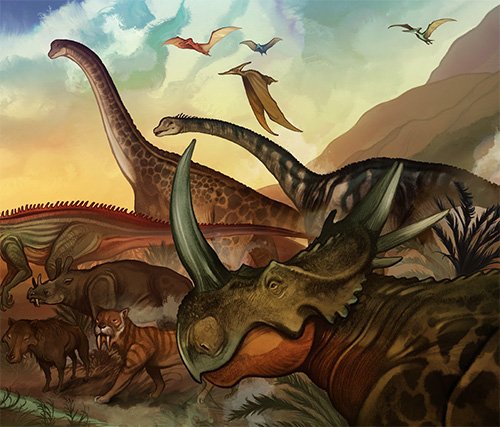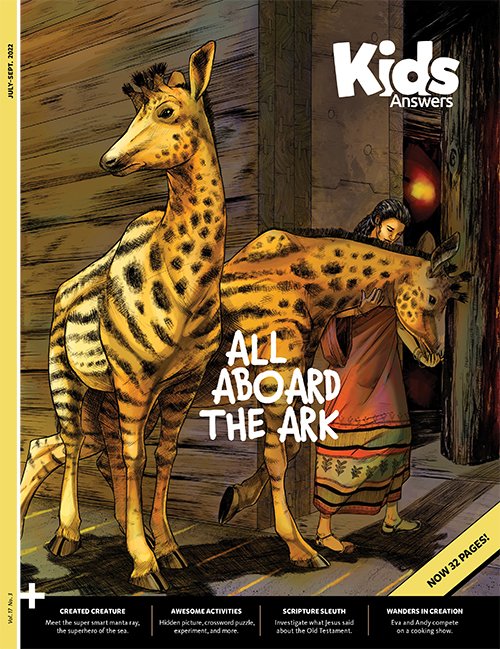All Aboard the Ark
Ark Animals
by Kaitlyn Iocco on July 1, 2022You probably enjoy going to the zoo and seeing the long-necked giraffes, fluffy-maned lions, and maybe even colorful butterflies. People have been visiting zoos to see exotic animals for hundreds of years. The oldest known zoo in the world started over 250 years ago as a royal menagerie (muh-NA-zhr-ee), which is a collection of wild animals. Today, there are more than 10,000 zoos around the world.
But did you know that the first and biggest collection of animals is thousands of years older? This menagerie is described in the Bible—Noah’s ark. But the ark wasn’t a floating zoo with giraffes poking their heads out the windows and monkeys, well, monkeying around. The ark was a real rescue ship that God used to save Noah, his family, and the animals from the flood.
Genesis 6 tells us that the world had become so wicked that God decided to destroy it with a flood. But Noah had faith in God. The Lord was pleased with Noah and told him to build an ark so that, when the flood came, Noah, his family, and the animals on the ark would be saved. God said to take two of every kind of animal on board “to keep them alive” (Genesis 6:20).
Not all the types of animals in the world today were on the ark. So which ones did Noah take? Was there enough room? Could just eight people care for all the animals? You’re about to find out.
How Did Noah Find All the Animals?
It would have been almost impossible for Noah to round up the animals to take on the ark. Genesis 6:19–21 says, “Of the birds according to their kinds, and of the animals according to their kinds, of every creeping thing of the ground, according to its kind, two of every sort shall come in to you to keep them alive” (emphasis added). From this verse, it sounds like the animals came to Noah. We know that God provided the plans for the ark, so we can be sure he provided in other ways too, like bringing the animals.
The Bible tells of other times God told animals what to do. When Elijah was in the wilderness, God made ravens bring him food (1 Kings 17:2–6). God opened the mouth of a donkey and allowed it to speak to a man named Balaam (Numbers 22:28–30). God performed miracles throughout the Bible to accomplish his plan.

How many animals were on the ark? Think of all the animals at the zoo. That’s a lot of critters, let alone all the animals in the whole world. Scientists guess there are around 1–2 million animal species on earth today. Many people wonder how all these animals fit on the ark. Well, they didn’t! Noah didn’t take every animal species. He only needed to take at least one pair of each kind of air-breathing land animal.
Kind is a bigger category than species and includes related animals that aren’t related to any other animals. If two animals can have a baby together, they are probably of the same created kind. For example, retrievers, poodles, and bulldogs are all dogs, but they’re not related to cats. A poodle and a retriever can have puppies, but a poodle and a cat can’t have babies.
When God created the original animal kinds during creation week, he put into each kind the information needed for the huge variety of species we see today. All the dog breeds we see in the world now came from the two members of the dog kind on the ark.
Creation scientists say the ark needed to carry fewer than 1,400 created kinds. So Noah didn’t have to fit nearly as many animals on the ark as you might think.
How Did the Animals Fit on the Ark?
The Bible tells us that the ark had three decks (floors) and was 300 cubits long, 50 cubits wide, and 30 cubits high. A cubit is an ancient measurement, roughly the distance from a man’s elbow to the tip of his longest finger. This means the ark was around 500 feet long—that’s as long as one and a half football fields! It was about 50 feet high and 85 feet wide. The building instructions God gave to Noah provided enough room for his family and all the animals.
What About the Big Animals?
Some animals that we think of as huge today looked different in Noah’s time. For example, long-necked giraffes aren’t the only living member of the giraffe kind. Another member is the okapi (oh-KAH-pi), an animal that lives in the forests of central Asia. Although it looks more like a horse than a giraffe, the okapi is a member of the giraffe kind, but is much smaller. The pair of animals Noah took on the ark to represent the giraffe kind could have been smaller, like an okapi, so they didn’t require as much space.
What About Picky Eaters and Meat Eaters?
Lions, tigers, and bears—oh my! Zoos today would never put a lion in the same pen as a gazelle. They wouldn’t want the gazelle to become the lion’s lunch! So how did Noah keep carnivores (meat eaters) among the other animals on the ark? When God first made the world, he said that people and animals would only eat plants. When death entered the world after Adam and Eve sinned, animals began eating other animals. Since animals survived by eating plants before the fall, it’s possible that carnivores could have survived without meat for the year they were on the ark. Just like some carnivores can go without meat for a time, animals with other special diets can too. For example, anteaters mostly eat ants (up to 35,000 every day), but they can also survive on fruits.
Noah could have kept meat eaters in cages or areas separate from other animals. It’s also possible that, to prepare for the flood, Noah and his family stored preserved meat on the ark to feed the animals. No matter how he did it, we can trust that God provided for the animals—even picky eaters.
How Did Noah and His Family Care for All the Animals?
On the ark, only eight people—Noah, his wife, his sons, and their wives—cared for all the animals. How did they do it? Noah’s family probably shared the work by each caring for a certain number of animals. They also could have built the ark with helpful systems in place to keep the animals fed and watered for several days.
How Did They Clean Up All the Poo?
If you have a pet, you know that what goes in must come out. Puppies have to be potty trained, and ponies need their stalls cleaned regularly. Removing waste is important for keeping an animal’s enclosure clean so they don’t get dirty and sick. There were a lot of animals to clean up after on the ark. In addition to mucking out stalls, Noah and his family might have installed a drainage system that could have carried urine from an animal’s stall into a container to later be dumped into the sea. Poo could have been carried in wheelbarrows to another system that would dump the waste.
Were Dinosaurs on the Ark?
People who believe in evolution say that dinosaurs died before humans ever lived. But the Bible says that dinosaurs were created on day six of creation week with the other land animals and with Adam and Eve. So we know that dinosaurs lived with humans and were still alive at the time of the flood. When you hear “dinosaur,” you probably picture a big one like T-rex. But the average dino was actually about the size of a large cow. It’s also likely that God sent Noah dinosaurs and other animals that were young and not yet fully grown.

What About You?
Noah and his family were able to build the ark, care for the animals, and survive the flood because God took care of them and provided for them. Just like he had a plan and provided for people in the Bible, you can be sure that God has a plan for your life and will take special care of you, too!
Related Downloads
All Aboard!
PDF DownloadKids Answers Magazine
All Aboard the Ark
The ark was a real rescue ship that God used to save Noah, his family, and the animals from the flood.
Browse Kids Issue- © 2025 Answers in Genesis
- Privacy Policy
- Contact
- About

